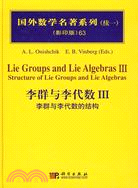商品簡介
目次
相關商品
商品簡介
The book contains a comprehensive account of the structure and classification of Lie groups and finite-dimensional Lie algebras (including semisimple,solvable,and of general type). In particular,a modem approach to the description of automorphisms and gradings of semisimple Lie algebras is given. A special chapter is devoted to models of the exceptional Lie algebras. The book contains many tables and will serve as a reference. At the same time many results are accompanied by short proofs.
Onishchik and Vinberg are internationally known specialists in their field; they are also well known for their monograph“Lie Groups and Algebraic Groups”(Springer-Verlag 1990).
The book will be immensely useful to graduate students in differential geometry,algebra and theoretical physics.
Onishchik and Vinberg are internationally known specialists in their field; they are also well known for their monograph“Lie Groups and Algebraic Groups”(Springer-Verlag 1990).
The book will be immensely useful to graduate students in differential geometry,algebra and theoretical physics.
目次
Introduction
Chapter 1. General Theorems
1. Lies and Engels Theorems
1.1. Lies Theorem
1.2. Generalizations of Lies Theorem
1.3. Engels Theorem and Corollaries to It
1.4. An Analogue of Engels Theorem in Group Theory
2. The Caftan Criterion
2.1. Invariant Bilinear Forms
2.2. Criteria of Solvability and Semisimplicity
2.3. Factorization into Simple Factors
3. Complete Reducibility of Representations and Triviality of the Cohomology of Semisimple Lie Algebras
3.1. Cohomological Criterion of Complete Reducibility
3.2. The Casimir Operator
3.3. Theorems on the Triviality of Cohomology
3.4. Complete Reducibility of Representations
3.5. Reductive Lie Algebras
4. Levi Decomposition
4.1. Levis Theorem
4.2. Existence of a Lie Group with a Given Tangent Algebra
4.3. Malcevs Theorem
4.4. Classification of Lie Algebras with a Given Radical
5.Linear Lie Groups
5.1. Basic Notions
5.2. Some Examples
5.3. Ados Theorem
5.4. Criteria of Linearizability for Lie Groups. Linearizer
5.5. Sufficient Linearizability Conditions
5.6. Structure of Linear Lie Groups
6. Lie Groups and Algebraic Groups
6.1. Complex and Real Algebraic Groups
6.2. Algebraic Subgroups and Subalgebras
6.3. Semisimple and Reductive Algebraic Groups
6.4. Polar Decomposition
6.5. Chevalley Decomposition
7. Complexification and Real Forms
7.1. Complexification and Real Forms of Lie Algebras
7.2. Complexification and Real Forms of Lie Groups
7.3. Universal Complexification of a Lie Group
8. Splittings of Lie Groups and Lie Algebras
8.1. Malcev Splittable Lie Groups and Lie Algebras
8.2. Definition of Splittings of Lie Groups and Lie Algebras
8.3. Theorem on the Existence and Uniqueness of Splittings
9. Caftan Subalgebras and Subgroups. Weights and Roots
9.1. Representations of Nilpotent Lie Algebras
9.2. Weights and Roots with Respect to a Nilpotent Subalgebra
9.3. Caftan Subalgebras
9.4. Caftan Subalgebras and Root Decompositions of Semisimple Lie Algebras
9.5. Caftan Subgroups
Chapter 2. Solvable Lie Groups and Lie Algebras
1. Examples
2. Triangular Lie Groups and Lie Algebras
3. Topology of Solvable Lie Groups and Their Subgroups
3.1. Canonical Coordinates
3.2. Topology of Solvable Lie Groups
3.3. Aspherical Lie Groups
3.4. Topology of Subgroups of Solvable Lie Groups
4. Nilpotent Lie Groups and Lie Algebras
4.1. Definitions and Examples
4.2. Malcev Coordinates
4.3. Cohomology and Outer Automorphisms
5. Nilpotent Radicals in Lie Algebras and Lie Groups
5.1. Nilradical
5.2. Nilpotent Radical
5.3. Unipotent Radical
6. Some Classes of Solvable Lie Groups and Lie Algebras
6.1. Characteristically Nilpotent Lie Algebras
6.2. Filiform Lie Algebras
6.3. Nilpotent Lie Algebras of Class 2
6.4. Exponential Lie Groups and Lie Algebras
6.5. Lie Algebras and Lie Groups of Type (I)
7. Linearizability Criterion for Solvable Lie Groups
Chapter 3. Complex Semisimple Lie Groups and Lie Algebras
1. Root Systems
1.1. Abstract Root Systems
1.2. Root Systems of Reductive Groups
1.3. Root Decompositions and Root Systems for Classical Complex Lie Algebras
1.4. Weyl Chambers and Simple Roots
1.5. Borel Subgroups and Subalgebras
1.6. The Weyl Group
1.7. The Dynkin Diagram and the Cartan Matrix
1.8. Classification of Admissible Systems of Vectors and Root Systems
1.9. Root and Weight Lattices
1.10. Chevalley Basis
2. Classification of Complex Semisimple Lie Groups and Their Linear Representations
2.1. Uniqueness Theorems for Lie Algebras
2.2. Uniqueness Theorem for Linear Representations
2.3. Existence Theorems
2.4. Global Structure of Connected Semisimple Lie Groups
2.5. Classification of Connected Semisimple Lie Groups
2.6. Linear Representations of Connected Reductive Algebraic Groups
2.7. Dual Representations and Bilinear Invariants
2.8. The Kernel and the Image of a Locally Faithful Linear Representation
2.9. The Casimir Operator and Dynkin Index
2.10. Spinor Group and Spinor Representation
3. Automorphisms and Gradings
3.1. Description of the Group of Automorphisms
3.2. Quasitori of Automorphisms and Gradings
3.3. Homogeneous Semisimple and Nilpotent Elements
3.4. Fixed Points of Automorphisms
3.5. One-dimensional Tori of Automorphisms and Z-gradings
3.6. Canonical Form of an Inner Semisimple Automorphism
3.7. Inner Automorphisms of Finite Order and Zm-gradings of Inner Type
3.8. Quasitorus Associated with a Component of the Group of Automorphisms
3.9. Generalized Root Decomposition
3.10. Canonical Form of an Outer Semisimple Automorphism
3.11. Outer Automorphisms of Finite Order and Zm-gradings of Outer Type
3.12. Jordan Gradings of Classical Lie Algebras
3.13. Jordan Gradings of Exceptional Lie Algebras
Chapter 4. Real Semisimple Lie Groups and Lie Algebras
1. Classification of Real Semisimple Lie Algebras
1.1. Real Forms of Classical Lie Groups and Lie Algebras
1.2. Compact Real Form
1.3. Real Forms and Involutory Automorphisms
1.4. Involutory Automorphisms of Complex Simple Algebras
1.5. Classification of Real Simple Lie Algebras
2. Compact Lie Groups and Complex Reductive Groups
2.1. Some Properties of Linear Representations of Compact Lie Groups
2.2. Selfoadjointness of Reductive Algebraic Groups
2.3. Algebralcity of a Compact Lie Group
2.4. Some Properties of Extensions of Compact Lie Groups
2.5. Correspondence Between Real Compact and Complex Reductive Lie Groups
2.6. Maximal Tori in Compact Lie Groups
3. Cartan Decomposition
3.1. Cartan Decomposition of a Semisimple Lie Algebra
3.2. Caftan Decomposition of a Semisimple Lie Group
3.3. Conjugacy of Maximal Compact Subgroups of Semisimple Lie Groups
3.4. Topological Structure of Lie Groups
3.5. Classification of Connected Semisimple Lie Groups
3.6. Linearizer of a Semisimple Lie Group
4. Real Root Decomposition
4.1. Maximal R-Diagonalizable Subalgebras
4.2. Real Root Systems
4.3. Satake Diagrams
4.4. Split Real Semisimple Lie Algebras
4.5. Iwasawa Decomposition
4.6. Maximal Connected Triangular Subgroups
4.7. Cartan Subalgebras of a Real Semisimple Lie Algebra
5. Exponential Mapping for Semisimple Lie Groups
5.1. Image of the Exponential Mapping
5.2. Index of an Element of a Lie Group
5.3. Indices of Simple Lie Groups
Chapter 5. Models of Exceptional Lie Algebras
1. Models Associated with the Cayley Algebra
1.1, Cayley Algebra
1.2. The Algebra G2
1.3. Exceptional Jordan Algebra
1.4. The Algebra F4
1.5. The Algebra E6
1.6. The Algebra E7
1.7. Unified Construction of Exceptional Lie Algebras
2. Models Associated with Gradings
Chapter 6. Subgroups and Subalgebras of Semisimple Lie Groups and Lie Algebras
1. Regular Subalgebras and Subgroups
1.1. Regular Subalgebras of Complex Semisimple Lie Algebras
1.2. Description of Semisimple and Reductive Regular Subalgebras
1.3. Parabolic Subalgebras and Subgroups
1.4. Examples of Parabolic Subgroups and Flag Manifolds
1.5. Parabolic Subalgebras of Real Semisimple Lie Algebras
1.6. Nonsemisimple Maximal Subalgebras
2. Three-dimensional Simple Subalgebras and Nilpotent Elements
2.1. sι2-triples
2.2. Three-dimensional Simple Subalgebras of Classical Simple Lie Algebras
2.3. Principal and Semiprincipal Three-dimensional Simple Subalgebras
2.4. Minimal Ambient Regular Subalgebras
2.5. Minimal Ambient Complete Regular Subalgebras
3. Semisimple Subalgebras and Subgroups
3.1. Semisimple Subgroups of Complex Classical Groups
3.2. Maximal Connected Subgroups of Complex Classical Groups
3.3. Semisimple Subalgebras of Exceptional Complex Lie Algebras
3.4. Semisimple Subalgebras of Real Semisimple Lie Algebras
Chapter 7. On the Classification of Arbitrary Lie Groups and Lie Algebras of a Given Dimension
1. Classification of Lie Groups and Lie Algebras of Small Dimension
1.1. Lie Algebras of Small1 Dimension
1.2. Connected Lie Groups of Dimension < 3
2. The Space of Lie Algebras. Deformations and Contractions
2.1. The Space of Lie Algebras
2.2. Orbits of the Action of the Group Gιn(k) on ι(k)
2.3. Deformations of Lie Algebras
2.4. Rigid Lie Algebras
2.5. Contractions of Lie Algebras
2.6. Spaces ιn(k) for Small n
Tables
References
Author Index
Subject Index
Chapter 1. General Theorems
1. Lies and Engels Theorems
1.1. Lies Theorem
1.2. Generalizations of Lies Theorem
1.3. Engels Theorem and Corollaries to It
1.4. An Analogue of Engels Theorem in Group Theory
2. The Caftan Criterion
2.1. Invariant Bilinear Forms
2.2. Criteria of Solvability and Semisimplicity
2.3. Factorization into Simple Factors
3. Complete Reducibility of Representations and Triviality of the Cohomology of Semisimple Lie Algebras
3.1. Cohomological Criterion of Complete Reducibility
3.2. The Casimir Operator
3.3. Theorems on the Triviality of Cohomology
3.4. Complete Reducibility of Representations
3.5. Reductive Lie Algebras
4. Levi Decomposition
4.1. Levis Theorem
4.2. Existence of a Lie Group with a Given Tangent Algebra
4.3. Malcevs Theorem
4.4. Classification of Lie Algebras with a Given Radical
5.Linear Lie Groups
5.1. Basic Notions
5.2. Some Examples
5.3. Ados Theorem
5.4. Criteria of Linearizability for Lie Groups. Linearizer
5.5. Sufficient Linearizability Conditions
5.6. Structure of Linear Lie Groups
6. Lie Groups and Algebraic Groups
6.1. Complex and Real Algebraic Groups
6.2. Algebraic Subgroups and Subalgebras
6.3. Semisimple and Reductive Algebraic Groups
6.4. Polar Decomposition
6.5. Chevalley Decomposition
7. Complexification and Real Forms
7.1. Complexification and Real Forms of Lie Algebras
7.2. Complexification and Real Forms of Lie Groups
7.3. Universal Complexification of a Lie Group
8. Splittings of Lie Groups and Lie Algebras
8.1. Malcev Splittable Lie Groups and Lie Algebras
8.2. Definition of Splittings of Lie Groups and Lie Algebras
8.3. Theorem on the Existence and Uniqueness of Splittings
9. Caftan Subalgebras and Subgroups. Weights and Roots
9.1. Representations of Nilpotent Lie Algebras
9.2. Weights and Roots with Respect to a Nilpotent Subalgebra
9.3. Caftan Subalgebras
9.4. Caftan Subalgebras and Root Decompositions of Semisimple Lie Algebras
9.5. Caftan Subgroups
Chapter 2. Solvable Lie Groups and Lie Algebras
1. Examples
2. Triangular Lie Groups and Lie Algebras
3. Topology of Solvable Lie Groups and Their Subgroups
3.1. Canonical Coordinates
3.2. Topology of Solvable Lie Groups
3.3. Aspherical Lie Groups
3.4. Topology of Subgroups of Solvable Lie Groups
4. Nilpotent Lie Groups and Lie Algebras
4.1. Definitions and Examples
4.2. Malcev Coordinates
4.3. Cohomology and Outer Automorphisms
5. Nilpotent Radicals in Lie Algebras and Lie Groups
5.1. Nilradical
5.2. Nilpotent Radical
5.3. Unipotent Radical
6. Some Classes of Solvable Lie Groups and Lie Algebras
6.1. Characteristically Nilpotent Lie Algebras
6.2. Filiform Lie Algebras
6.3. Nilpotent Lie Algebras of Class 2
6.4. Exponential Lie Groups and Lie Algebras
6.5. Lie Algebras and Lie Groups of Type (I)
7. Linearizability Criterion for Solvable Lie Groups
Chapter 3. Complex Semisimple Lie Groups and Lie Algebras
1. Root Systems
1.1. Abstract Root Systems
1.2. Root Systems of Reductive Groups
1.3. Root Decompositions and Root Systems for Classical Complex Lie Algebras
1.4. Weyl Chambers and Simple Roots
1.5. Borel Subgroups and Subalgebras
1.6. The Weyl Group
1.7. The Dynkin Diagram and the Cartan Matrix
1.8. Classification of Admissible Systems of Vectors and Root Systems
1.9. Root and Weight Lattices
1.10. Chevalley Basis
2. Classification of Complex Semisimple Lie Groups and Their Linear Representations
2.1. Uniqueness Theorems for Lie Algebras
2.2. Uniqueness Theorem for Linear Representations
2.3. Existence Theorems
2.4. Global Structure of Connected Semisimple Lie Groups
2.5. Classification of Connected Semisimple Lie Groups
2.6. Linear Representations of Connected Reductive Algebraic Groups
2.7. Dual Representations and Bilinear Invariants
2.8. The Kernel and the Image of a Locally Faithful Linear Representation
2.9. The Casimir Operator and Dynkin Index
2.10. Spinor Group and Spinor Representation
3. Automorphisms and Gradings
3.1. Description of the Group of Automorphisms
3.2. Quasitori of Automorphisms and Gradings
3.3. Homogeneous Semisimple and Nilpotent Elements
3.4. Fixed Points of Automorphisms
3.5. One-dimensional Tori of Automorphisms and Z-gradings
3.6. Canonical Form of an Inner Semisimple Automorphism
3.7. Inner Automorphisms of Finite Order and Zm-gradings of Inner Type
3.8. Quasitorus Associated with a Component of the Group of Automorphisms
3.9. Generalized Root Decomposition
3.10. Canonical Form of an Outer Semisimple Automorphism
3.11. Outer Automorphisms of Finite Order and Zm-gradings of Outer Type
3.12. Jordan Gradings of Classical Lie Algebras
3.13. Jordan Gradings of Exceptional Lie Algebras
Chapter 4. Real Semisimple Lie Groups and Lie Algebras
1. Classification of Real Semisimple Lie Algebras
1.1. Real Forms of Classical Lie Groups and Lie Algebras
1.2. Compact Real Form
1.3. Real Forms and Involutory Automorphisms
1.4. Involutory Automorphisms of Complex Simple Algebras
1.5. Classification of Real Simple Lie Algebras
2. Compact Lie Groups and Complex Reductive Groups
2.1. Some Properties of Linear Representations of Compact Lie Groups
2.2. Selfoadjointness of Reductive Algebraic Groups
2.3. Algebralcity of a Compact Lie Group
2.4. Some Properties of Extensions of Compact Lie Groups
2.5. Correspondence Between Real Compact and Complex Reductive Lie Groups
2.6. Maximal Tori in Compact Lie Groups
3. Cartan Decomposition
3.1. Cartan Decomposition of a Semisimple Lie Algebra
3.2. Caftan Decomposition of a Semisimple Lie Group
3.3. Conjugacy of Maximal Compact Subgroups of Semisimple Lie Groups
3.4. Topological Structure of Lie Groups
3.5. Classification of Connected Semisimple Lie Groups
3.6. Linearizer of a Semisimple Lie Group
4. Real Root Decomposition
4.1. Maximal R-Diagonalizable Subalgebras
4.2. Real Root Systems
4.3. Satake Diagrams
4.4. Split Real Semisimple Lie Algebras
4.5. Iwasawa Decomposition
4.6. Maximal Connected Triangular Subgroups
4.7. Cartan Subalgebras of a Real Semisimple Lie Algebra
5. Exponential Mapping for Semisimple Lie Groups
5.1. Image of the Exponential Mapping
5.2. Index of an Element of a Lie Group
5.3. Indices of Simple Lie Groups
Chapter 5. Models of Exceptional Lie Algebras
1. Models Associated with the Cayley Algebra
1.1, Cayley Algebra
1.2. The Algebra G2
1.3. Exceptional Jordan Algebra
1.4. The Algebra F4
1.5. The Algebra E6
1.6. The Algebra E7
1.7. Unified Construction of Exceptional Lie Algebras
2. Models Associated with Gradings
Chapter 6. Subgroups and Subalgebras of Semisimple Lie Groups and Lie Algebras
1. Regular Subalgebras and Subgroups
1.1. Regular Subalgebras of Complex Semisimple Lie Algebras
1.2. Description of Semisimple and Reductive Regular Subalgebras
1.3. Parabolic Subalgebras and Subgroups
1.4. Examples of Parabolic Subgroups and Flag Manifolds
1.5. Parabolic Subalgebras of Real Semisimple Lie Algebras
1.6. Nonsemisimple Maximal Subalgebras
2. Three-dimensional Simple Subalgebras and Nilpotent Elements
2.1. sι2-triples
2.2. Three-dimensional Simple Subalgebras of Classical Simple Lie Algebras
2.3. Principal and Semiprincipal Three-dimensional Simple Subalgebras
2.4. Minimal Ambient Regular Subalgebras
2.5. Minimal Ambient Complete Regular Subalgebras
3. Semisimple Subalgebras and Subgroups
3.1. Semisimple Subgroups of Complex Classical Groups
3.2. Maximal Connected Subgroups of Complex Classical Groups
3.3. Semisimple Subalgebras of Exceptional Complex Lie Algebras
3.4. Semisimple Subalgebras of Real Semisimple Lie Algebras
Chapter 7. On the Classification of Arbitrary Lie Groups and Lie Algebras of a Given Dimension
1. Classification of Lie Groups and Lie Algebras of Small Dimension
1.1. Lie Algebras of Small1 Dimension
1.2. Connected Lie Groups of Dimension < 3
2. The Space of Lie Algebras. Deformations and Contractions
2.1. The Space of Lie Algebras
2.2. Orbits of the Action of the Group Gιn(k) on ι(k)
2.3. Deformations of Lie Algebras
2.4. Rigid Lie Algebras
2.5. Contractions of Lie Algebras
2.6. Spaces ιn(k) for Small n
Tables
References
Author Index
Subject Index
主題書展
更多
主題書展
更多書展今日66折
您曾經瀏覽過的商品
購物須知
大陸出版品因裝訂品質及貨運條件與台灣出版品落差甚大,除封面破損、內頁脫落等較嚴重的狀態,其餘商品將正常出貨。
特別提醒:部分書籍附贈之內容(如音頻mp3或影片dvd等)已無實體光碟提供,需以QR CODE 連結至當地網站註冊“並通過驗證程序”,方可下載使用。
無現貨庫存之簡體書,將向海外調貨:
海外有庫存之書籍,等候約45個工作天;
海外無庫存之書籍,平均作業時間約60個工作天,然不保證確定可調到貨,尚請見諒。
為了保護您的權益,「三民網路書店」提供會員七日商品鑑賞期(收到商品為起始日)。
若要辦理退貨,請在商品鑑賞期內寄回,且商品必須是全新狀態與完整包裝(商品、附件、發票、隨貨贈品等)否則恕不接受退貨。
























